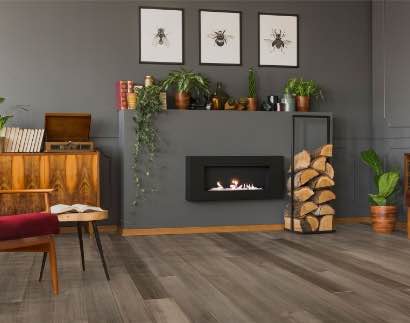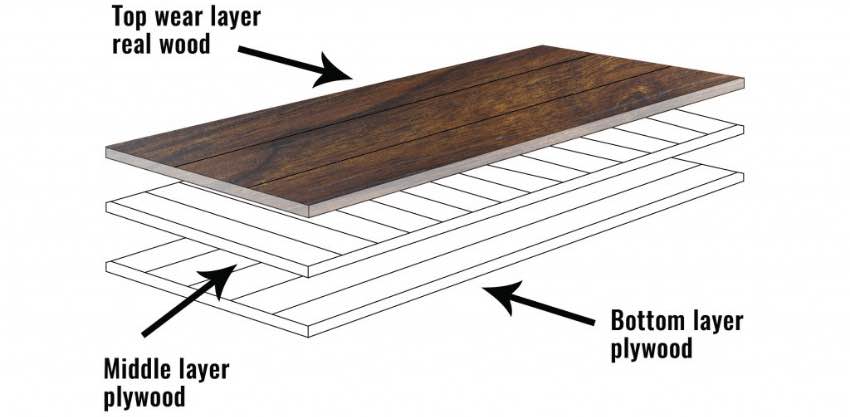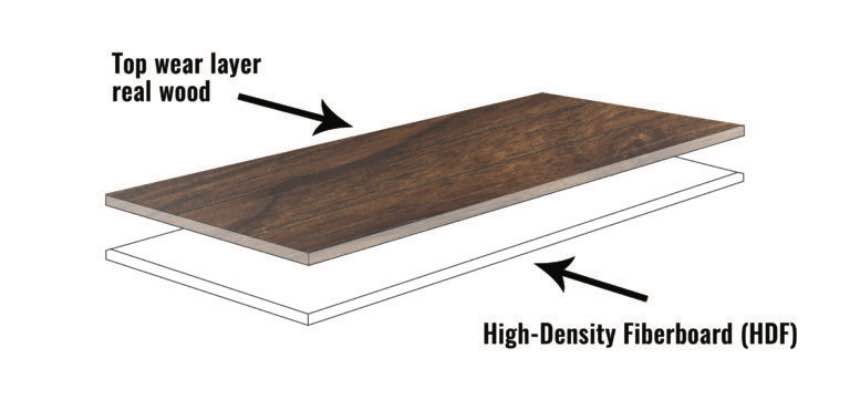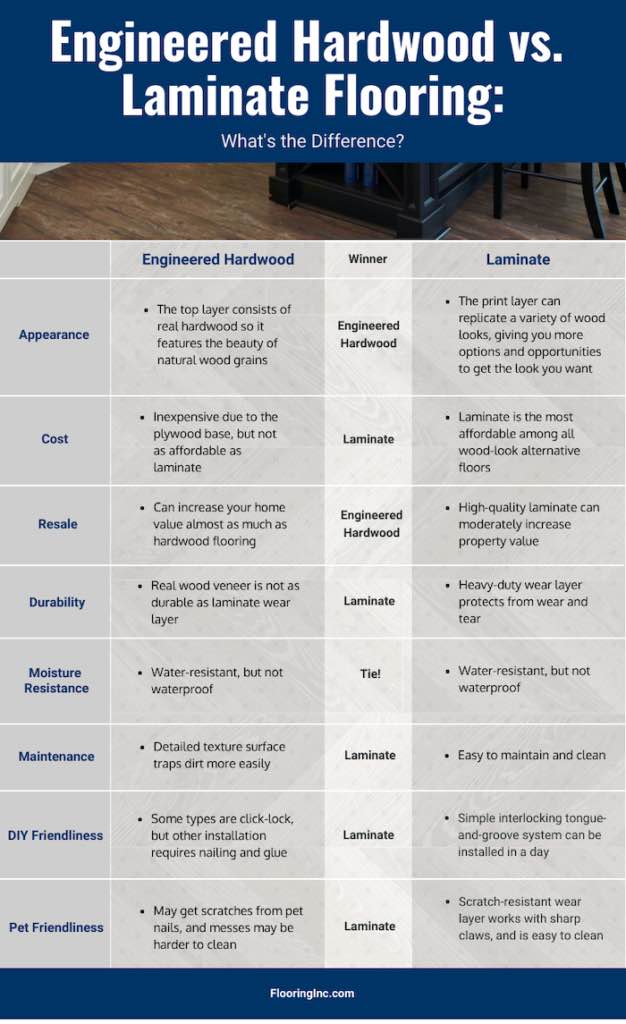Engineered Hardwood vs. Laminate Flooring
Not sure whether to go with engineered hardwood vs. laminate flooring
for your home remodel? While both materials achieve that beautiful wood-look floor, there are key differences between the two. Here’s everything you need to know to make your decision.
Wood-look flooring has been trending for years now, and now, instead of shelling out for a solid hardwood floor, you can choose from plenty of inexpensive wood-alternative options that are just as stylish.
Among the most popular wood flooring alternatives are engineered hardwood and laminate plank flooring, two flooring types that tend to get used interchangeably because of their similarities. But if you’re trying to decide which material to go with for your home or business, it’s important that you know what makes these products stand apart.
In this engineered hardwood vs. laminate flooring showdown, we’ll lay out all the pros, cons, and major differences that should know. Keep reading to determine which wood-look floor is the best choice for you.
Wood-look flooring has been trending for years now, and now, instead of shelling out for a solid hardwood floor, you can choose from plenty of inexpensive wood-alternative options that are just as stylish.
Among the most popular wood flooring alternatives are engineered hardwood and laminate plank flooring, two flooring types that tend to get used interchangeably because of their similarities. But if you’re trying to decide which material to go with for your home or business, it’s important that you know what makes these products stand apart.
In this engineered hardwood vs. laminate flooring showdown, we’ll lay out all the pros, cons, and major differences that should know. Keep reading to determine which wood-look floor is the best choice for you.
What’s the Difference Between Engineered Hardwood vs. Laminate Flooring?

Laminate flooring and engineered hardwood are sometimes confused with each other because they can look similar. However, despite similar appearances, there are key differences between them.
Most importantly, engineered wood contains a top layer of solid wood while laminate uses a photographic layer coated with a wear layer to achieve the wood-look surface.
Most importantly, engineered wood contains a top layer of solid wood while laminate uses a photographic layer coated with a wear layer to achieve the wood-look surface.
What is Engineered Hardwood?

Part wood floor, part man-made materials, engineered wood flooring offers the best of both worlds. The real wood veneer layer offers the style and unique look of naturally occurring planks.
Engineered wood features a thin veneer top layer of solid wood. The natural top layer makes engineered wood just as durable as traditional hardwood and provides the same classic, timeless look.
Then there’s the core of the plank, typically made from layers of plywood or high-density fiberboard (HDF). These layers are oriented perpendicular to each other, which creates a strong lattice structure in the core. The stability and durability of the plank come from this lattice. A mix of wax and adhesive holds this all together, which provides some water-resistance compared to solid wood.
Engineered wood features a thin veneer top layer of solid wood. The natural top layer makes engineered wood just as durable as traditional hardwood and provides the same classic, timeless look.
Then there’s the core of the plank, typically made from layers of plywood or high-density fiberboard (HDF). These layers are oriented perpendicular to each other, which creates a strong lattice structure in the core. The stability and durability of the plank come from this lattice. A mix of wax and adhesive holds this all together, which provides some water-resistance compared to solid wood.
Layers of Engineered Hardwood
Engineered wood consists either of latticed layers of plywood or from a single dense layer of HDF.




- Wear/Veneer layer: Here’s where you find the veneer of genuine wood that gives your flooring its beautiful, unique look. The wood veneer can be almost any wood species you want, usually an old-growth wood like oak or hickory. Veneer layers usually show the real character of the wood with natural splits and knots.
- Core layer: Plywood and HDF cores offer some moisture resistance, especially if mixed with wax and other water-repellent materials. If you have a plywood core, the plywood layers are oriented to create a lattice structure, which provides durability and stability. An HDF core is a lot more dense than plywood, and it’s a single, solid layer.
- Backing: This is the foundation of your floor. Typically it’s made of plywood or HDF.
Pros of Engineered Hardwood
Cons of Engineered Hardwood
- DIY installation: No contractor? No problem! Engineered wood boats a tongue and groove installation system – you can either loose lay or installed it with glue.
- Versatility: Engineered wood can be installed on all levels, making the possibilities endless.
- Options: Engineered hardwood comes in hand-scraped, wirebrushed, smooth and distressed surfaces, giving you the option of adding a bit of special touch to the product and complementing your decor.
- Green: Engineered wood flooring offers a more environmentally friendly product and often uses up to 70% repurposed wood waste for the core and backing – that means all your recycle-loving friends will approve and it looks just as good on your floor!
Cons of Engineered Hardwood
- Cannot always be refinished: Unlike solid hardwood which can be refinished, engineered wood has a thin wood veneer on top. Always consult the manufacturer’s instructions before you consider refinishing. Attempting to refinish the engineered wood could potentially damage the product.
- Mindset: Some people prefer to know that hardwood is strictly made out of a solid wood plank, just like purchasing designer jeans, you want to make sure it’s authentic. Though engineered wood is not made out of 100% solid wood, you can think of it as “smart” hardwood, a real hardwood floor that is more versatile than a solid wood plank. For some only solid hardwood will do, but for many, the pros of an engineered wood floor often tip the scales.
- Not recommended for full bathrooms or basements: Since these areas are prone to leaks and flooding, you’ll want a more water-resistant floor. You can make your laminate floor more water-resistant by installing underlayment and a vapor barrier as well as using the glue-down installation method.
- Cost: Engineered hardwood is more of an investment. Since the top veneer is real hardwood, it is completely unique to each plank with real knots and unique grain with no pattern repeats like some laminates. Since engineered wood looks, feels, and walks like a solid hardwood, it has a premium price compared to a laminate floor.
What is Laminate?
A low-cost alternative to natural wood, laminate is a durable floor that comes with a highly realistic image layer that mimics wood planks (or other materials like stone or even metal). Beneath this layer you’ll find a core of particleboard made from heat-pressed wood fibers.
Laminate was the pioneer for realistic wood-look flooring back in the ‘70s, and other types of flooring have caught on and have begun releasing their own realistic wood looks. Still, laminate looks and feels like real hardwood and holds strong as a popular wood-look floor thanks to its low-maintenance cleaning routine and a durable, scratch-resistant surface.
Laminate was the pioneer for realistic wood-look flooring back in the ‘70s, and other types of flooring have caught on and have begun releasing their own realistic wood looks. Still, laminate looks and feels like real hardwood and holds strong as a popular wood-look floor thanks to its low-maintenance cleaning routine and a durable, scratch-resistant surface.
Layers of Laminate Flooring

- Wear layer: The wear layer protects the floor from scratches, dents, and staining and provides the water-resistance needed for everyday spills and is usually embossed with texture. Many laminates are “Embossed in Register” meaning that their textures are synchronized with the image layer to create an incredibly realistic wood-look floor.
- Image layer: This holds the pattern or print, making the laminate look like wood. The image layer can include rougher, more natural-looking scrapes, and knots just like the real deal.
- Core layer: A core layer gives the floor its durability and stability. This layer is typically made of compressed medium-density fiberboard (aka HDF) and. This can resistant water, but isn’t necessarily waterproof.
- Backing layer: Here’s the backbone of a laminate plank, helping provide stability for the floor and helping to keep water from penetrating the flooring from underneath.
Pros of Laminate Flooring
Cons of Laminate Flooring
- Durable: Laminate flooring’s supreme durability makes it a good option for high-traffic areas or homes with kids and pets.
- Scratch resistance: Laminate has a strong wear layer that protects the floor from scratches, dents, wear, and staining, all the things pets love to test our floors on.
- Realistic wood and stone looks: Laminate floor planks often have synchronized embossing that matches the image layer that further mimics a natural hardwood look and can also have the look and feel of a hand-scraped hardwood, embossed wood, distressed hardwood or come in textured or smooth. Unlike real hardwood, you’ll see consistent quality across all laminate flooring boards.
- Can resist some water: Advances in construction are improving laminate’s water-resistant capabilities. While not as resistant to standing water as some other wood-look floors, many laminates use multiple features to repel water from the core. Some of these features include tight-locking tongue and groove systems, advanced core materials, and thick backing layers.
- Easy to clean and maintain: Simply mop or sweep up messes as needed. No floor waxing required.
- Easy to install: Laminate flooring is designed as a floating floor, meaning that it doesn’t secure to the ground underneath, but rather “floats” by the means of an interlocking design.
- Cost effective: Laminate floors are an affordable alternative to hardwood floors. Lower price and lower maintenance? Yes, please!
Cons of Laminate Flooring
- Not completely waterproof: While laminate flooring has come a long way in its water-resistant capabilities, it still cannot tolerate standing pools of water. Unlike vinyl, laminate’s water resistance works from top to bottom rather than bottom to top. If you have moisture issues with your subfloor, you’ll still need a vapor barrier.
- Not recommended for full bathrooms or basements: Since these areas are prone to leaks and flooding, you’ll want a more water-resistant floor. You can make your laminate floor more water-resistant by installing underlayment and a vapor barrier as well as using the glue-down installation method.
- Sound: If installed poorly, laminate floors can create a hollow, empty sound. Every product comes with thorough installation instructions, and if you’re really worried, you can always hire an expert. Plus, a good underlayment can make for a quieter laminate floor.
- Not real wood: While the top image layer can feature highly realistic wood-look visuals, it’s still not real wood. It won’t have quite the same texture or feel compared to the solid wood veneer of engineered hardwood.
Engineered Hardwood vs. Laminate: The Showdown
Now that you have the fundamentals down, let’s compare and contrast engineered hardwood vs. laminate flooring. Here’s how the two match up in the most important categories to homeowners:
Appearance
While laminate flooring has come a long way in constructions and a variety of prints, engineered hardwood wins on its natural beauty. With a solid hardwood top layer, engineered hardwood is as close as it gets to a natural wood floor. But as we all know, looks don’t tell the whole story.
Winner: Engineered hardwood
While laminate flooring has come a long way in constructions and a variety of prints, engineered hardwood wins on its natural beauty. With a solid hardwood top layer, engineered hardwood is as close as it gets to a natural wood floor. But as we all know, looks don’t tell the whole story.
Winner: Engineered hardwood
Cost
Of all the wood-look alternative flooring options, laminate is the most affordable. If the price is important to you, laminate flooring offers a quality, cost-effective option.
Winner: Laminate
Of all the wood-look alternative flooring options, laminate is the most affordable. If the price is important to you, laminate flooring offers a quality, cost-effective option.
Winner: Laminate
Resale
Engineered wood can increase your home value almost as much as hardwood flooring. Investing in a high-quality laminate floor can also moderately raise a property’s value. The sure bet here, however, is engineered hardwood.
Winner: Engineered hardwood
Engineered wood can increase your home value almost as much as hardwood flooring. Investing in a high-quality laminate floor can also moderately raise a property’s value. The sure bet here, however, is engineered hardwood.
Winner: Engineered hardwood
Durability
Laminate’s sturdy, scratch-resistant wear layer makes this floor strong in the durability category. Laminate is also becoming more resistant to moisture. Meanwhile, engineered hardwood is a bit more vulnerable to wear and tear since it has a real wood veneer.
Winner: Engineered hardwood
Laminate’s sturdy, scratch-resistant wear layer makes this floor strong in the durability category. Laminate is also becoming more resistant to moisture. Meanwhile, engineered hardwood is a bit more vulnerable to wear and tear since it has a real wood veneer.
Winner: Engineered hardwood
Moisture Resistance
Both engineered hardwood and laminate are made of water-repellent materials such as wax and adhesive. This means they are water-resistant, but not completely waterproof. There are also ways to install these floors that can increase resistance to moisture, but they’re still not completely waterproof.
Winner: Tie!
Both engineered hardwood and laminate are made of water-repellent materials such as wax and adhesive. This means they are water-resistant, but not completely waterproof. There are also ways to install these floors that can increase resistance to moisture, but they’re still not completely waterproof.
Winner: Tie!
Maintenance
Laminate is far easier to maintain than engineered wood flooring. Engineered hardwood is easy to clean, but the material also has more holes and grains that can collect dirt, while laminate is smooth and easy to wipe clean.
Winner: Laminate
Laminate is far easier to maintain than engineered wood flooring. Engineered hardwood is easy to clean, but the material also has more holes and grains that can collect dirt, while laminate is smooth and easy to wipe clean.
Winner: Laminate
DIY-Friendliness
Laminate installation is more of a DIY endeavor than engineered wood floors. Installing laminate planks doesn’t require any nailing or glue, like some types of engineered hardwood. It’s a simple interlocking tongue-and-groove system that can typically be installed in a day. If you’re a DIY go-getter, laminate flooring is for you.
Winner: Laminate
Laminate installation is more of a DIY endeavor than engineered wood floors. Installing laminate planks doesn’t require any nailing or glue, like some types of engineered hardwood. It’s a simple interlocking tongue-and-groove system that can typically be installed in a day. If you’re a DIY go-getter, laminate flooring is for you.
Winner: Laminate
Pet-Friendliness
Pet owners love laminate floors for their scratch-resistant superpowers. The problem with natural wood is that scratches from pet nails or even scents from their accidents can be tricky to remove. Laminate floors are more forgiving to our pets.
Winner: Laminate
Pet owners love laminate floors for their scratch-resistant superpowers. The problem with natural wood is that scratches from pet nails or even scents from their accidents can be tricky to remove. Laminate floors are more forgiving to our pets.
Winner: Laminate
Which Floor is Best For You?
The winner of engineered hardwood vs. laminate flooring really depends. Both are strong, durable floors that are less expensive than natural wood, but laminate flooring typically costs less.
Both materials mimic a natural wood floor beautifully, but if you’re all about natural beauty, you might prefer the solid wood top of an engineered hardwood floor.
Give each of these pros and cons some thought, and determine what factors are most important to you. The best part? You can order free samples of both engineered hardwood and laminate flooring and compare and contrast for yourself.
Both materials mimic a natural wood floor beautifully, but if you’re all about natural beauty, you might prefer the solid wood top of an engineered hardwood floor.
Give each of these pros and cons some thought, and determine what factors are most important to you. The best part? You can order free samples of both engineered hardwood and laminate flooring and compare and contrast for yourself.
Ready to create your dream home with a new floor?




